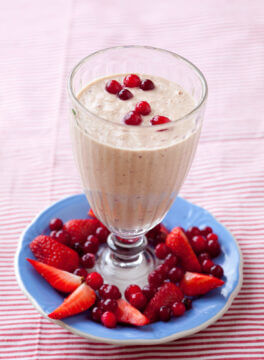Think of the packaging of a food – including the words on the front of the package – as advertisement. As we all know, advertising is often misleading. Its function is to make you buy the product, not necessarily to give you accurate information. Therefore, always read the ingredients list in fine print on the back of a food package to shed light on the real contents of the product.
The nutrition facts area on the package discloses serving size, number of servings per package, calories per serving, calories from fat and total fat. It specifically lists grams of saturated fat and trans fat, cholesterol, sodium, total carbohydrates, dietary fiber and sugar. It also lists major vitamins and minerals and their percentages of the U.S. daily requirement based on a 2000-calorie diet.
Some of this information may be useful. But for the most part, numbers in nutrition give only relative values.
Daily vitamin requirements are different for just about every human being on this planet, and a food’s caloric value can have varying effects on body weight – depending on what food it comes from, what time of day that food is eaten and whether the consumer has a fast or slow metabolism.
For example, a hundred calories from a cookie made with white sugar and white flour can set off a chain reaction that results in weight gain and cravings for more sweets, while a hundred calories from a vegetable or whole grain are more likely to be transformed into sustained energy, satiety and no weight gain. Eating the cookie at bedtime can result in more weight gain than eating the same cookie at lunch because in the evening our metabolism slows down in preparation for sleep, while at midday it functions at its peak. And a cookie-eater with a naturally slow metabolism will take longer to burn the hundred calories than one who enjoys a fast metabolism.
The nutrition facts area also includes a listing of the product’s ingredients, named in descending order – the first ingredient listed is the largest component in a food, the last one listed is the smallest component. It is this information that we really need to focus on.
Here are a few general rules about ingredients lists:
● The fewer ingredients, the better.
● Stay away from products that list many ingredient words you can’t pronounce or define. Such words most likely refer to nonfood items, which could be any number of harmful chemicals, dyes, artificial flavors or fillers.
● Avoid foods containing curing agents, flavor enhancers or preservatives. Words and initials to look out for are nitrates or nitrites, monosodium glutamate (MSG), sulfites, potassium bromate, butylated hydroxyanisole (BHA), butylated hydroxytoluene (BHT) and tertiary butylhydroquinone (TBHQ).
● Always look for baking powder that contains no aluminum.
● Be suspicious of words like fortified, enhanced or enriched and of vitamins that are listed as actual ingredients. Pro-ducts touting these attributes were most likely stripped of essential nutrients during processing and then supplemented with artificial nutrients to compensate for the loss, as in white flour and white-flour products. Be aware that artificial nutrients, produced in laboratories and then added to various products, are never an adequate replacement for the natural nutrients lost in processing.
● Consuming artificially isolated vitamins – even those that are said to come from “natural” sources – is not equivalent to consuming the actual food sources of those vitamins. Only whole foods deliver vitamins in a form that the body can fully recognize. Artificial vitamins are simply not absorbed in the same way as vitamins that naturally occur in the foods that contain them.
● Be alert to sugar, a ubiquitous ingredient – not only in sweet foods, where you would expect it, but also in canned or processed vegetables, soups, cereals, granola, dairy products, soy milk, juices, nut butters and even salt. Sugar can appear as fructose, maltose, dextrose, sucrose, corn syrup, high-fructose corn syrup, glucose syrup, brown sugar, evaporated cane juice, raw sugar, Sucanat or concentrated fruit juice.
● Be wary of sugar-free and diet products. Sugar is often replaced with artificial sweeteners. They are serious neurotoxins. They can also play havoc with your blood sugar level.
● Don’t be fooled by fat-free or low-fat products. They are often saturated with corn syrup to make up for the texture and taste provided by the fat that was removed. Whenever a fat molecule is manipulated through processing, the beneficial quality of the fat and the taste of the resulting food are compromised.
● When it comes to oils, avoid refined, solvent-extracted and deodorized oils. Unless the label specifically states that the product is unrefined, assume that it is refined. Avoid margarine, which is completely hydrogenated, and cheap vegetable oils, which are often partially hydrogenated – as they contain health-damaging trans fats.
● Wordings like natural, all natural or whole grain do not guarantee a natural and wholesome food. Advertisements will pick up on the latest health and diet trends to convince you that a product is healthful and natural. When a label says whole grain, make sure that it says 100 percent whole grain or whole wheat. Many products claim to be whole grain, but the first ingredient listed on the label is bleached flour, and the whole-grain flour comes somewhere near the end of the list. This placement reveals that the product is made predominantly from white flour and only minimally from whole-grain flour.
In today’s world of processed foods it is necessary to become a food detective. Always bring you magnifying glass with you!
Marika Blossfeldt
Author . Speaker . Coach
https://marikab.com/cookbook/
Breakfast Oat Smoothie
Print RecipeIngredients
- 1 cup (240 ml) orange juice
- 1 cup (240 ml) rolled oats
- One 2-inch piece of aloe (optional) – use only the mucilaginous part
- 1 handful of fresh (or frozen) berries of your choice
- ½ apple, cored, cut into chunks
- 2 tablespoons peanut or almond butter
- 1 banana, cut into chunks
Instructions
Food Recipe Instructions
Place all ingredients in a blender and puree. Add some water for a thinner consistency.



















